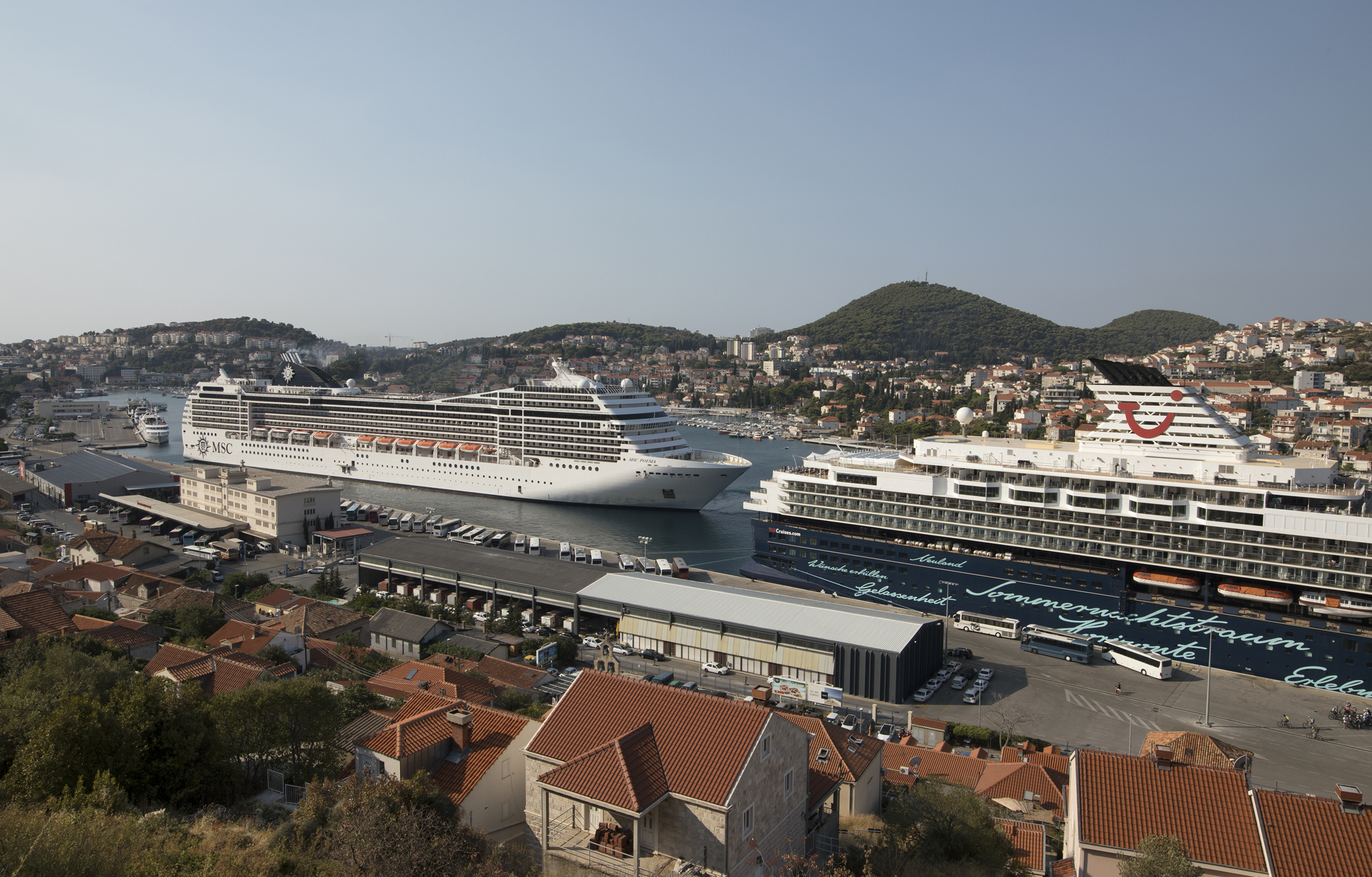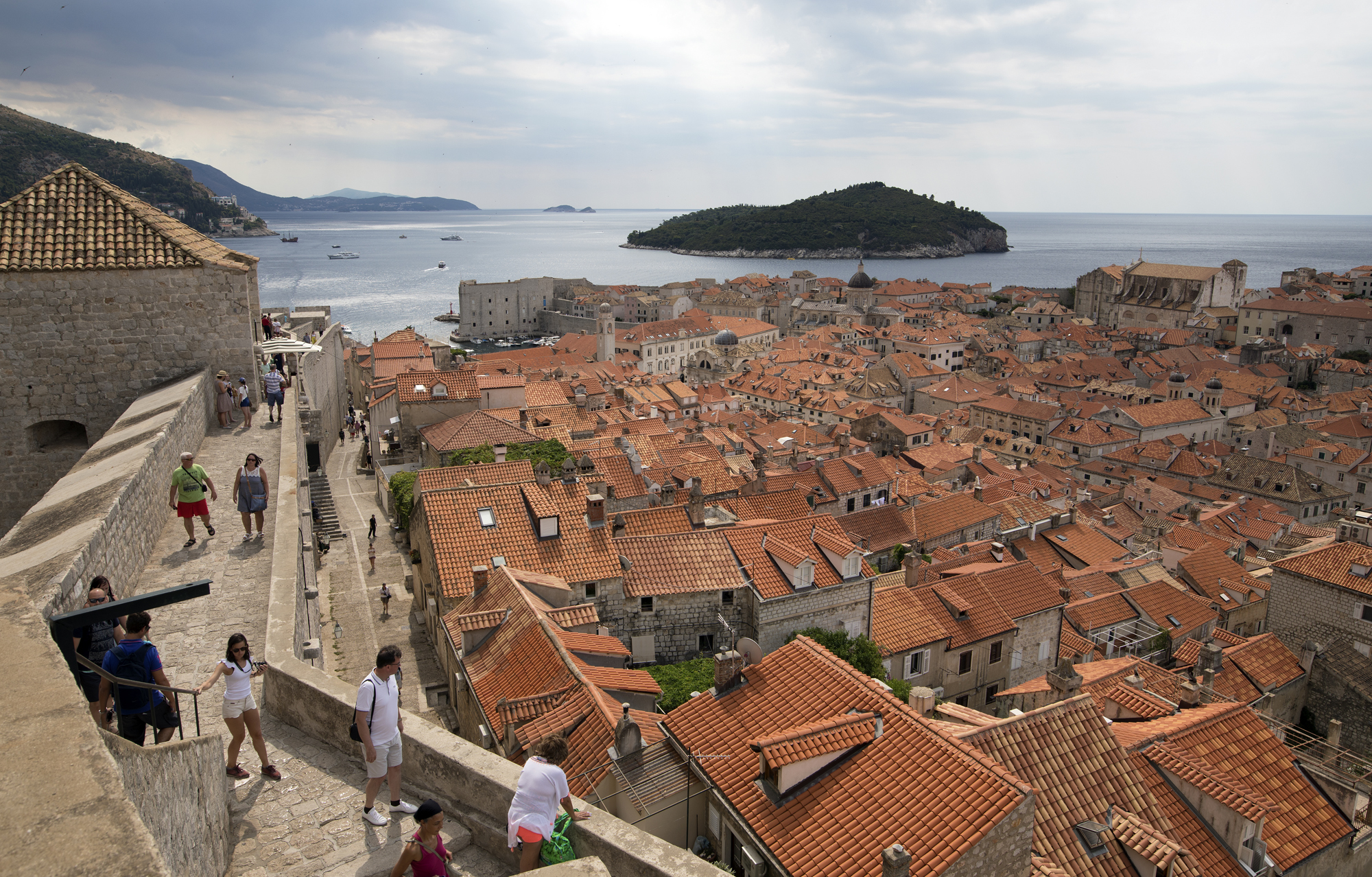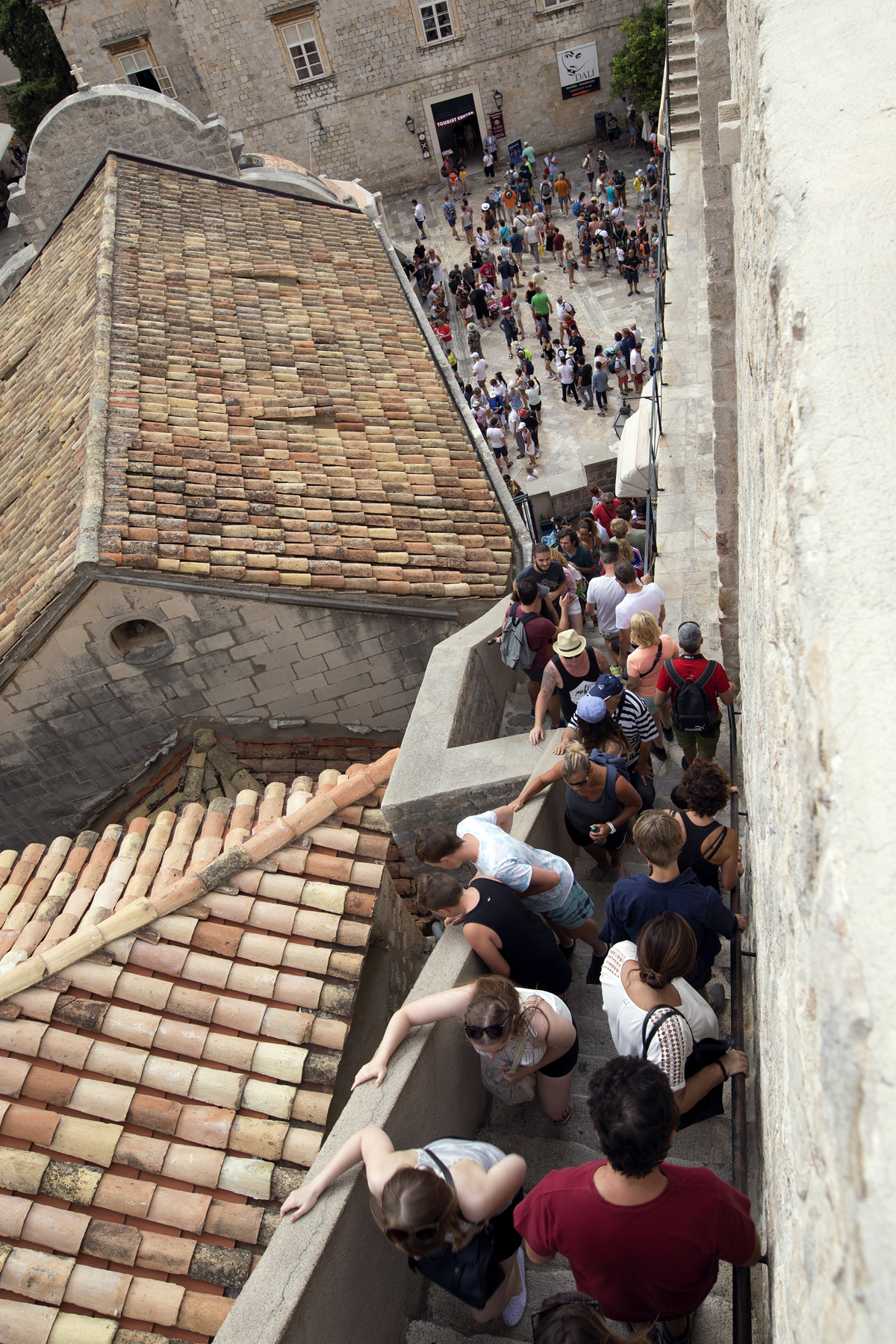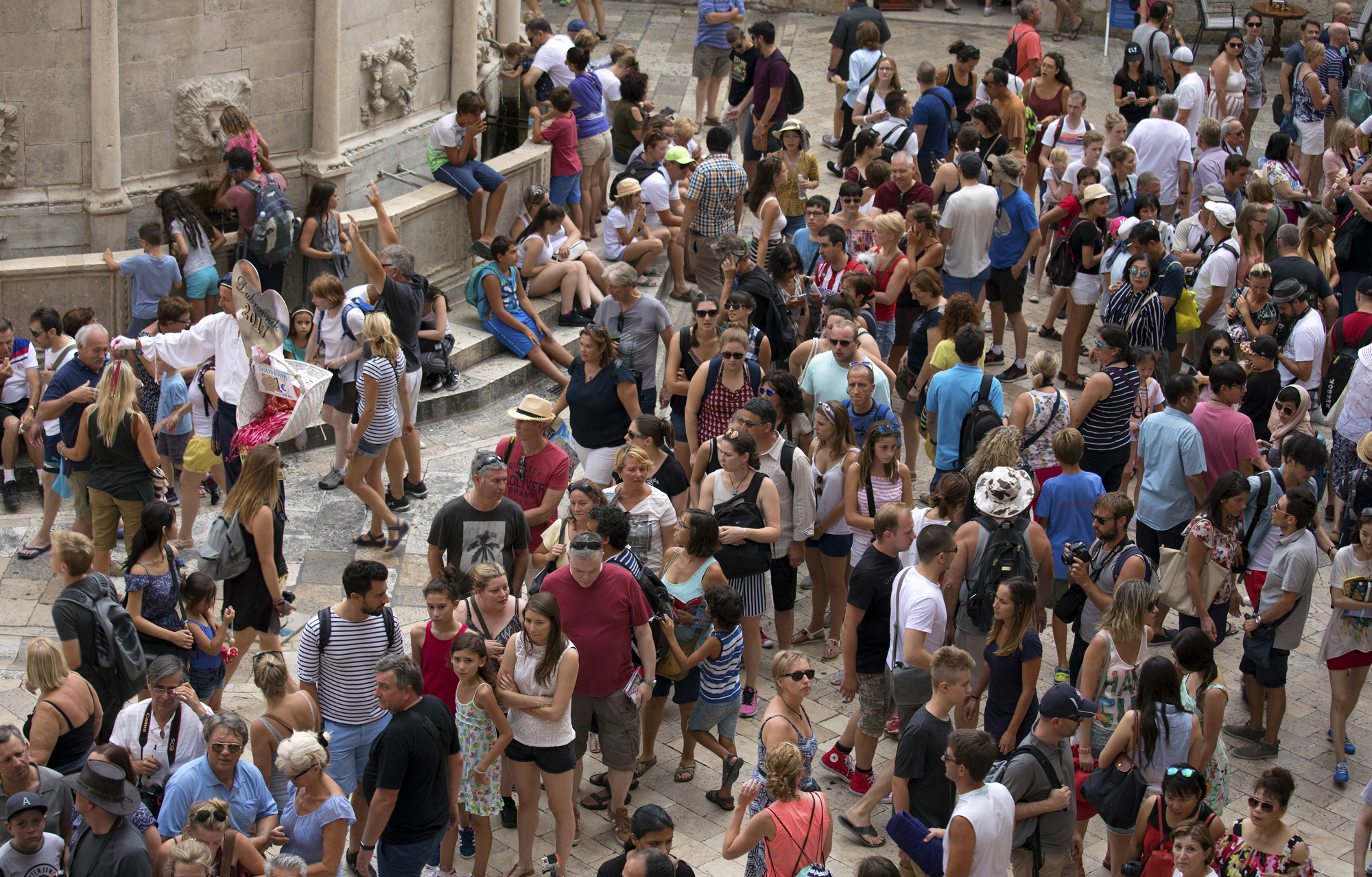Vastly outnumbered by tourists, the few remaining residents of Dubrovnik’s iconic Old Town rue the loss of its identity, charm and way of life.
Viewed from the 15th-century Large Onofrio Fountain at one end of Stradun, the limestone main street in Dubrovnik’s Old Town, one might be forgiven for mistaking what Lord Byron called the ‘Pearl of the Adriatic’ for a scene from Tetris, the popular 1980s video game. Tourists pour in endless droves through the town gate. They move in different formations and directions. At times, there are so many of them they fill the entire space, as if pieces of a jigsaw puzzle completely obscuring the smooth, intricate stonework beneath their feet.
The town centre, which covers an area of roughly 18 hectares, can hold, and regularly does hold, 10,000 tourists at any one time. The narrow streets become clogged; lines of people barely move; they accidentally photobomb each other’s selfies. And in the midst of this chaos, a few stern individuals can be seeing rushing through the crowds, solemn and hurried as they try to run their daily errands. These are the locals, an endangered species. If, by any chance, the Old Town clears for a moment, the scene is breathtaking – a perfectly proportioned, medieval stone town, encircled by monumental walls topped with turrets and forts that have guarded its freedom for centuries. Its southern flank is lapped by the Adriatic, its north watched over by a hill named Srdj.
“Tourism in Dubrovnik in recent years has become a monster that is increasingly difficult to control.“
Lord Byron wasn’t exaggerating. Nor are the thousands of tourists who post pictures of Dubrovnik on social media with the hashtags #amazing, #beautiful #mustsee. The harmony between the corporeal and the spiritual has long preserved Dubrovnik. Since the 7th century, the town grew according to well-designed plans, in compliance with its scale and capacity. This is precisely the reason why this perfectly preserved former city-state is utterly, charmingly unique. It is why UNESCO placed it on the World Heritage List in 1979. It is why the producers of HBO’s ‘Game of Thrones’ decided it would be a perfect backdrop for King’s Landing, capital of the Seven Kingdoms. And now Dubrovnik is on many a traveller’s bucket list. See it before you die. But the town’s popularity has become its curse. It is now, after Venice, the second most popular cruise-ship destination on the Mediterranean.

Cruise ships in the harbor of Dubrovnik. Photo: © Ana Opalic
Last year, a staggering 1.2 million tourists visited Dubrovnik, 17 per cent up on 2016. This year looks set to break records again. And as tourist numbers rise, the Old Town’s real population falls. Out of 42,615 residents of wider Dubrovnik, only 1,557 are registered as living in the Old Town, 25 per cent fewer than in 2011. A third of them are older than 65. Some 22 per cent are considering moving, according to a recent survey by the Institute for the Restoration of Dubrovnik. “In town, we would go to sleep and wake up to all the noise. We spent months with our windows shut,” said Sandra Ivicevic-Bakulic, whose family moved out last year of the Old Town to the nearby settlement of Zlatni Potok to escape the tourists.Three generations of her family were born within the town’s walls. Of some 30 families on their street, only a handful are left. “The stress was too much to handle,” she said. “The town had lost everything we used to love about it.”
We need to stop counting people
Tourism is a central pillar of the Croatian economy, generating 9.5 billion euros in income last year and accounting for almost one fifth of the country’s economic output. Such figures, Tourism Minister Gari Capelli said in March, are “the best indicator of how far Croatian tourism has come.” But at what cost?
Dubrovnik the Movie Set
Dubrovnik has long been one of Europe’s most popular tourist destinations, but its stock soared when HBO launched the medieval fantasy epic Game of Thrones in 2011, with Dubrovnik’s Old Town doubling as King’s Landing, the capital of Westeros. Since then, tourist numbers have climbed between 9 and 12 percent annually, according to the Dubrovnik Tourist Board.
The streets where Cersei Lannister made her naked Walk of Atonement in the Season 5 finale as Septa Unella rang a bell and cried ‘Shame!’ are now similarly crowded with Game of Thrones tour guides and their rapt customers. Parts of The Last Jedi, the eighth installment of the Star Wars saga, were also filmed in Dubrovnik in 2016, as were scenes from the upcoming Robin Hood: Origins movie starring Taron Egerton and Jamie Foxx. Ivan Vukovic Vuka launched his own Game of Thrones tour in 2012. “So many more Americans and New Zealanders come here because of the show,” Vukovic said. “Game of Thrones and Dubrovnik have a lot of medieval history in common but during the tours tourists are not that much interested in Dubrovnik’s history,” he said, recounting how some tourists are puzzled as to where the walls of the Old Town are stored during the winter.
“I used to lead up to five tours per day but I don’t do more than three anymore,” he said. “I’m too tired if I work more and hence it’s not that interesting for tourists. It’s the same with Dubrovnik. It would be better for everyone if the city would settle for less profit.”
A tourist guide points at the filming location of the “Walk of Shame” from the TV series Game of Thrones. Photo: © Ana Opalic
Dubrovnik’s centuries-old infrastructure is coming apart at the seams, UNESCO has threatened to strip the town of its World Heritage status due to overcrowding and this year it placed third on CNN’s list of 12 places travellers might want to avoid this year. Venice was 4th. “Tourism in Dubrovnik in recent years has become a monster that is increasingly difficult to control. The city is more and more like Disneyland,” said Bozo Benic, president of the Dubrovnik Association of Architects. “That must end if we want to preserve the city’s identity and dignity and to ensure the quality of life.”
Mato Frankovic, who was elected mayor in June 2017, says he has already taken some steps to tackle the problem. He aims to cut the number of cruise ships to no more than two per day, spread throughout the week, and to limit the number of people inside the walls to 8,000 per day. He has already cut the number of tables that restaurants and cafes can put out and the number of souvenir stands. “We need to stop counting people and overnight stays and focus on quality instead,” said Frankovic. “After years of excess it will be difficult to accomplish a sustainable type of tourism in one year or even the four years of my mandate, but certain measures have already been implemented,” he said. “Dubrovnik cannot be a victim of its own success”.
The cruise ships were once a welcome sight, signifying the resurrection of a town that a little more than a quarter of a century ago was under siege from the Serb-dominated Yugoslav People’s Army during the 1991-95 war that followed Croatia split from Yugoslavia. There was no talk of limits or conditions. But then came more tourists, more cruise ships, more apartments for rent, more restaurants, more souvenir shops – until the town began to come apart at the seams. Dubrovnik was not built to hold this many people. When it rains, the contents of the medieval sewer system beneath Stradun spill out through manholes. Work began last winter to repair it.
Nor is the power supply big enough for all the restaurants and the air-conditioning units cooling each and every rented room in the town; a sub-station melted a few years ago due to the overload. The outer AC units raise the temperature of the town and damage the facades. There used to be a management plan for Dubrovnik’s Old Town which prescribed the use of every venue and surface, but it was abandoned in the 1980s and the town has developed without rhyme or reason ever since. The number of cafes, hotels, restaurants or apartments is not prescribed, nor is there a strategy for how to reconcile the needs of tourism with those of the local inhabitants.
A five-minute walk from Stradun, in the small, harmonious apartment of Ana Zuvela and her husband Davor Busnja, lunch simmers on the stove. There are a hostel and a few rental apartments nearby. Tourists stroll past the windows. “I could install a glass panel in the kitchen which opens up when you insert a penny so the tourists can watch us cook while the kids do their homework. We could have the more demanding ones round for dinner, so they can experience the local way of life,” Ana joked.
„Dubrovnik was, historically, a smart town, that’s why it was built as it was. Not anymore. Today it’s pretty, but dumb.”
A longing to preserve the way of life she knew as a child brought Ana back to the Old Town after she completed a postgraduate degree in Dublin. Her decision means her children are growing up in a pedestrian zone, neighbours offer them cakes while they play outside and in turn they help the elderly carry their groceries. Friends pop in uninvited for coffee after lunch; the neighbourhood chips in for the funeral of someone less fortunate. “I find it very important that we think of one another, that we’re not just another cog in this world of individualism,” said Ana, who works for the state Institute for Development and International Relations. “We want to live here and it costs us dearly – noise, crowds, disorder, living in a small flat because the price of real-estate has gone through the roof… Everything is more expensive if you live in the very centre. But unlike Dubrovnik itself, we’ve settled for a limited place to expand.”

Dubrovnik from above. Photo: © Ana Opalic
But surely they reap the benefits of Dubrovnik the money-maker? Not so. “We take toilet paper to our child’s kindergarten, plastic cups to our child’s school because they don’t have the means to buy such items,” said Davor. “There’s a big discrepancy between the town’s ample budget and the quality of life of its inhabitants. I honestly can’t see where the money from tourism goes.” Ana added: “There is nothing organised for children or the elderly. There aren’t enough physicians. Public venues in the centre generate a lot of income and that money used to be re-invested into the same venues; they were renovated, paved. Today, the town is exploited but not renewed. Dubrovnik was, historically, a smart town, that’s why it was built as it was. Not anymore. Today it’s pretty, but dumb.”
Davor, an architect originally from the Croatian capital Zagreb, said he used to get goose bumps every time he walked down Stradun.“The place has such grandiosity, balance and beauty. I see this effect on foreigners who visit it during the winter, when Dubrovnik can be admired in peace,” he said. Ana agreed: “Everyone deserves a chance to be awestruck by Dubrovnik.”
Frankovic, the mayor, conceded that not enough had been invested in the town’s infrastructure in recent years. Since his election, he said, repair work had been carried out on the water and sewer system as well as some roads. The local authorities plan three new kindergartens, a new school and 40 apartments to be built under an affordable-housing plan to encourage young families to stay. A retirement home is also envisaged. Up until a few years ago, there was talk of extending the tourist season in Dubrovnik. Now, tourist numbers drop off only between November and March, a brief window for the town and its inhabitants to recover and ready themselves for the next round. Even in off-season, the Old Town becomes a movie set.
Not just an ATM
Tourism has devoured Dubrovnik, said Nikolina Farcic, president of the Guild of Caterers and Tourist Workers. “The whole town placed all its hopes in tourism and there is a shortage of workers. There isn’t enough accommodation for them or for the younger population of the town. Everything is for rent and the rates are astronomical,” said Farcic. “Standards used to be high because hotels hired educated and qualified staff. Nowadays, there’s too much of everything and everyone is working in tourism, even those who saw tourism as a sort of plan B.”

Stunning scenery of the old town of Dubrovnik. Photo: © Ana Opalic
„We don’t manage tourism, it manages us.“
She sits in the Mariners’ Club, one of only a handful of still reasonably-priced places visited mainly by locals, alongside Srdjan Kera, a former mariner and president of a non-governmental organisation called Nazbilj. Kera was behind a satirical ‘funeral’ for Dubrovnik staged a decade ago. Even then, the locals were moving out and bookshops, butchers and grocery stores were becoming restaurants, cafes and candy stores. “Back then, it was felt we had too many souvenir shops. There were about fifty of them. Today, there are more than twice as many. It’s total chaos,” he said. “The town has been killed.” He pointed to a nearby cafe: “They get issued a permit for five tables and they put out nine.”

Every year flocks of foreign tourists pour into the city. Photo: © Ana Opalic
Farcic agreed. “We don’t manage tourism, it manages us.” Outside the walls, the sea is strewn with kayaks and jet-skis; a sailboat packed with people glides by and a huge yacht bears down on swimmers; a cruise ship approaches, ready to disgorge.
Sandra Ivicevic-Bakulic now sits above the commotion, gazing down on the Old Town where she used to live and the lush island of Lokrum from her terrace in Zlatni Potok, a settlement built in the 1970s for workers of the Babin Kuk hotel complex. Finally, there is peace. But Sandra and her husband, Ivan, lament that their children will never know Dubrovnik as they had. “Our children do not see this town as their own, as it was for us when we were children,” said Ivan. “We used to go out on Stradun, while they go to the old bus terminal because the centre is too expensive. A few days ago, our girls couldn’t go for a midnight swim because the beaches are locked overnight,” he said. Dubrovnik “belongs to the concessionaires, because everything is rented out”. “This is what it has come to – take the money and run. This town is not just an ATM machine, it’s someone’s home.”
First published on 18 July 2018 on Balkaninsight.com.
This text is protected by copyright: © Barbara Matejcic/BIRN. If you are interested in republication, please contact the editorial team.
Copyright information on pictures, graphics and videos are noted directly at the illustrations. Cover picture: © Ana Opalic.
This article was produced as part of the Balkan Fellowship for Journalistic Excellence, supported by the ERSTE Foundation and Open Society Foundations, in cooperation with the Balkan Investigative Reporting Network.
